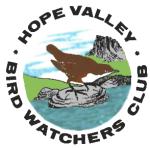
HOPE VALLEY BIRD WATCHERS CLUB

As we arrived, we were greeted by a Jay flying over and a Carrion Crow harassing a Buzzard. It never got better than that, but we saw the usual waterfowl including a pintail. At the feeding station, we had good views of Willow Tit and Great Spotted Woodpecker. In all, we recorded 43 species despite the disturbance caused by the building work and developments around the site. Bittern had been seen in two hides, but managed to avoid us successfully. The weather was really good - little wind, warm and sunny.
Strong, blustery winds meant the intrepid trio of members skipped Worlaby Carrs in preference for the shelter of the hides at Blacktoft, and as a result saw some fantastic birds, including: Marsh Harrier, Hen Harrier and Bittern. The supporting cast of about 48 other species included: Golden Plover, Lapwing, Black-tailed Godwit, a couple of elusive Spotted Redshank, Goldeneye, Skylark, Stonechat and a good selection of wildfowl.
A glorious day with almost ideal lighting revealed the magnificent plumage of many of the wildfowl and waders, including Goosander, Goldeneye, Lapwing and Great Crested Grebe. A Green Woodpecker was heard "yaffling" most of the day and a glimpse caught on a couple of occasions. A solitary Whooper Swan was present and a possible Sand Martin flew through. The day's tally was 61 species.
A gloomy misty start became even more miserable as the unexpected rain came. The birds, however, more than made up for the weather. The small finches, Siskin and Redpoll, were twittering and flying all over the place, but it was the huge flock of 200-300 Brambling marauding through the fallen beech mast that stole the show. About 30 species in total.
Before midday the intrepid foursome that had ventured out for the 7 AM start had accumulated over 60 species, including the common summer visitors: Blackcap, Willow Warbler, Chiffchaff, Swallow, House Martin, Sand Martin, Cuckoo, Sedge Warbler, Tree Pipit, Common Tern, Redstart and Yellow Wagtail. Singing Woodlark was possibly heard in the distance. Fantastic views of 5 Buzzards were savoured during the lunch break. An excellent day with 70 species for company.
The evening was overcast, cool and breezy but this didn't bother the birds, with 28 species observed in total. The highlights were Ring Ouzels, Stonechat and Whinchat.
About a dozen members and guests turned up for the evening walk. A stroll alongside the lake, which was suffering from an algal bloom, produced the usual wildfowl species, though the most interesting find was a juvenile Coot brooding a clutch of eggs, though an adult was in the water near the nest. Finally, the sunset and a few members glimpsed a Hobby before the Nightjars put on one of the best performances for years: wing clapping, calling, churring and fluttering flight just above our heads. As we were leaving two Woodcocks flew over a couple of times.
A bright and sunny day but with a strong breeze that seemed to
affect smaller birds and so only 44 species were recorded. There were quite
a few waders - lots of Lapwings, Dunlins, Avocets and Golden Plover and
Redshanks, a few Ruffs, 2 Little Stints and a single Spotted Redshank from
Marshland Hide. More Spotted Redshank and a solitary Black-tailed Godwit
were found elsewhere before the day ended at Ousefleet Hide. This is often
dry at this time of year, but this week's high tides supplied plenty of
water and lots of birds. The highlight of the day was finding a very active
Red-necked Phalarope there.
Plenty of wildfowl were back on their winter quarters, but there were no visiting waders. There were over 1,000 Coot present and around 200 Mute Swans. The Lin Dyke hide was burned down in the Spring and has yet to be replaced. Fifty species were recorded including Pintail, Kingfisher and two Black Swans.
No rarities were seen but we observed 64 species plus 3 other possible species. From the Eric Morecambe hide were hundreds of Eider, Scoter and Knot, and many other waders and wildfowl. Back on the main reserve, there were winter thrushes, but most the enjoyment was provided by a Marsh Harrier and up to 4 Buzzards.
The rain held off long enough for 7 club members to spend a pleasant morning but the strong wind made it difficult to find the smaller birds. Despite this 41 species were recorded with loads of the usual wild fowl but no surprises. We had good view of a couple of Lesser Redpolls and fleeting glimpses of Green Woodpecker, Kingfisher and a trio of flying Redshanks.
After a wet start we were rewarded by a fine and sunny day, and some excellent birds. The highlight was sightings of Hawfinches on two separate occasions, despite the tree surgery going on around the church. We also had good views of a Kingfisher. Among the 56 species recorded were 4 Grey Partridges, single flocks of Siskins and Redpolls, at least 3 Sparrowhawks, over 30 Goosanders and both Marsh and Willow Tits.